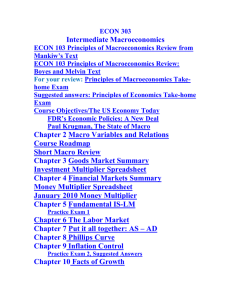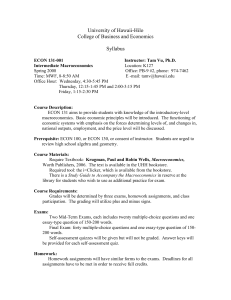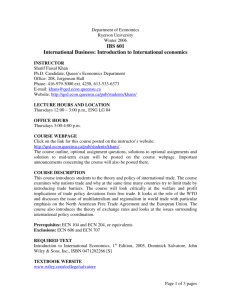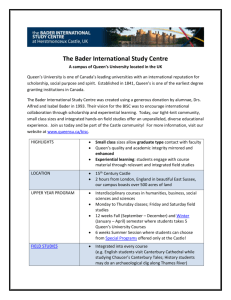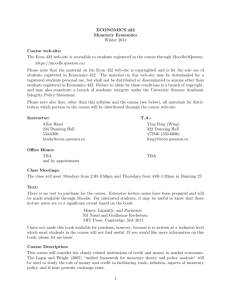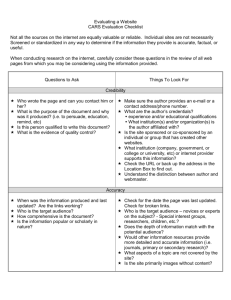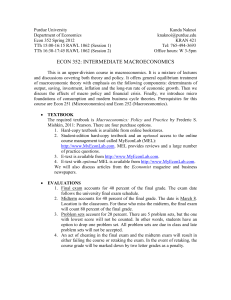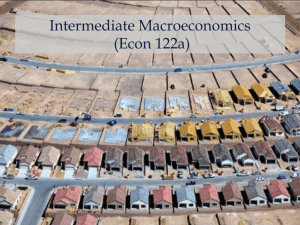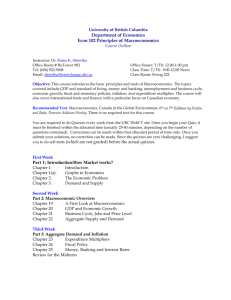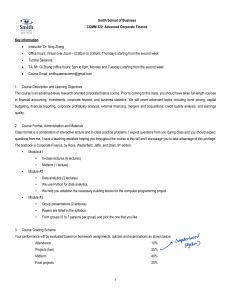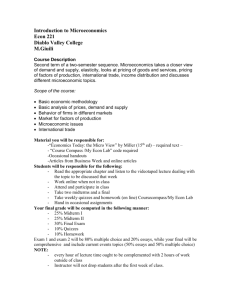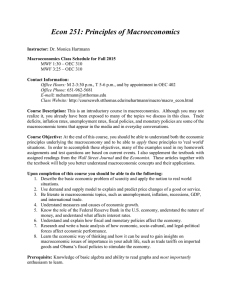Winter 2014 - Queen's University
advertisement
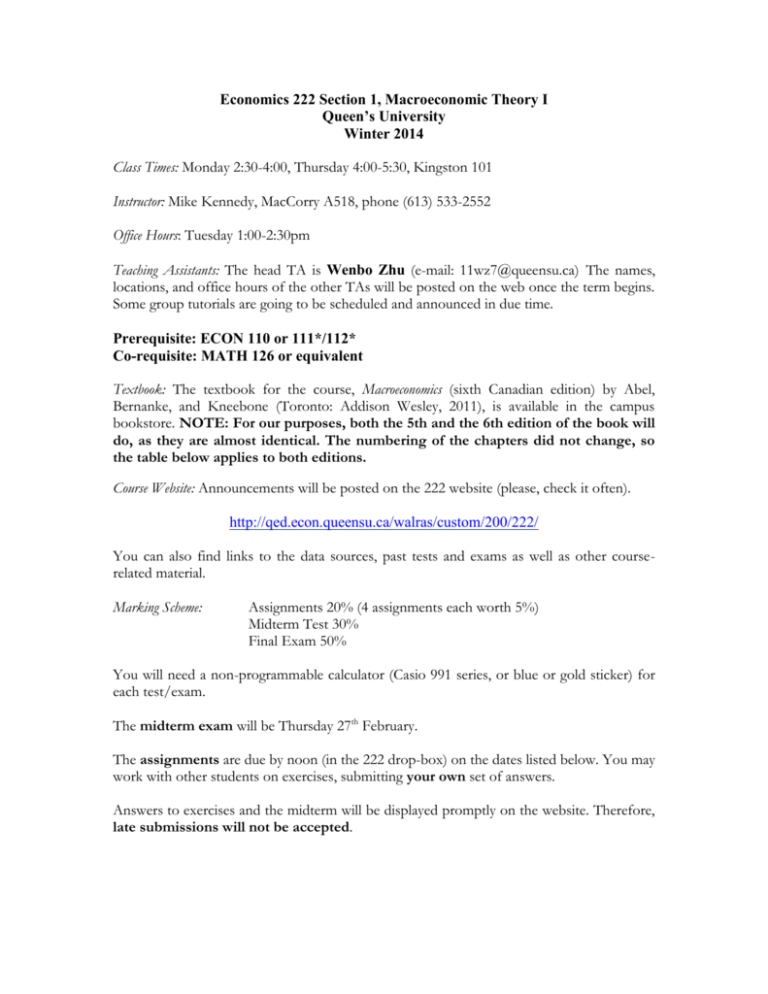
Economics 222 Section 1, Macroeconomic Theory I Queen’s University Winter 2014 Class Times: Monday 2:30-4:00, Thursday 4:00-5:30, Kingston 101 Instructor: Mike Kennedy, MacCorry A518, phone (613) 533-2552 Office Hours: Tuesday 1:00-2:30pm Teaching Assistants: The head TA is Wenbo Zhu (e-mail: 11wz7@queensu.ca) The names, locations, and office hours of the other TAs will be posted on the web once the term begins. Some group tutorials are going to be scheduled and announced in due time. Prerequisite: ECON 110 or 111*/112* Co-requisite: MATH 126 or equivalent Textbook: The textbook for the course, Macroeconomics (sixth Canadian edition) by Abel, Bernanke, and Kneebone (Toronto: Addison Wesley, 2011), is available in the campus bookstore. NOTE: For our purposes, both the 5th and the 6th edition of the book will do, as they are almost identical. The numbering of the chapters did not change, so the table below applies to both editions. Course Website: Announcements will be posted on the 222 website (please, check it often). http://qed.econ.queensu.ca/walras/custom/200/222/ You can also find links to the data sources, past tests and exams as well as other courserelated material. Marking Scheme: Assignments 20% (4 assignments each worth 5%) Midterm Test 30% Final Exam 50% You will need a non-programmable calculator (Casio 991 series, or blue or gold sticker) for each test/exam. The midterm exam will be Thursday 27th February. The assignments are due by noon (in the 222 drop-box) on the dates listed below. You may work with other students on exercises, submitting your own set of answers. Answers to exercises and the midterm will be displayed promptly on the website. Therefore, late submissions will not be accepted. Course Content Overview: Since thoughtfully-applied economics can be a useful way to organize one’s thoughts, the goal of the course is to teach you how take an “economic approach” to analyze complex issues and current events. This will involve some math and an understanding of how economic models work, how they are applied, and their limitations. At times this approach will require some work with different data sources, preparing graphs or tables, performing some calculations and interpreting the results. Ultimately, the applicable skill I’m trying to teach is the ability to understand how economic policy and shocks affect the economy as reflected in aggregate macro variables such as output, interest rates, prices and employment. What defines macroeconomics is mainly a broader view of things and the types of questions that are posed. We will look at the economy as a whole, rather than the specific or ‘micro’ details (though these are also important). As for the questions: Why are some countries rich while others are poor? What impacts do high energy prices have on the economy? What determines interest rates? How does the Bank of Canada influence the economy? etc. Some economics issues we consider in this course include: - Decisions individuals face such as whether to save or consume, work or enjoy leisure. - Decisions employers face either to hire more employees or expand their factory’s capacity. - Decisions government face such as how to best respond to economic shocks. Topic Defining Macroeconomics Measurement & Accounting Productivity & Employment Saving & Investment International Debt Chapter 1 Week 1 2 2 3 3 4 4 5 5 Economic Growth READING WEEK Money and Inflation 6 7 6 7 8 Business Cycles IS-LM Model 8 9 9 10 Due Dates Assignment 1 due January 24th Assignment 2 due February 7th Mid term February 27th Assignment 3 due March 14th Exchange Rates & 10 11 Macro Policy Exchange Rates & 10 12 Assignment 4 due Macro Policy March 28th Unemployment & 13 13 Classes end on April Inflation 4th th th 222 Final Exam TBA – will occur sometime between April 10 - 26 , 2014 ________________________________________________________________________ Statement on Academic Integrity Academic integrity is constituted by the five core fundamental values of honesty, trust, fairness, respect and responsibility (see www.academicintegrity.org). These values are central to the building, nurturing and sustaining of an academic community in which all members of the community will thrive. Adherence to the values expressed through academic integrity forms a foundation for the "freedom of inquiry and exchange of ideas" essential to the intellectual life of the University (see the Senate Report on Principles and Priorities). Students are responsible for familiarizing themselves with the regulations concerning academic integrity and for ensuring that their assignments conform to the principles of academic integrity. Information on academic integrity is available in the Arts and Science Calendar (see Academic Regulation 1), on the Arts and Science website (see http://www.queensu.ca/calendars/artsci/pg532.html), and from the instructor of this course. Departures from academic integrity include plagiarism, use of unauthorized materials, facilitation, forgery and falsification, and are antithetical to the development of an academic community at Queen's. Given the seriousness of these matters, actions which contravene the regulation on academic integrity carry sanctions that can range from a warning or the loss of grades on an assignment to the failure of a course to a requirement to withdraw from the university. __________________________________________ The material for ECON 222 is copyrighted and is for the sole use of registered students. The material on the website may be downloaded for a registered student’s personal use, but shall not be distributed or disseminated to anyone other than students registered in ECON 222. Failure to abide by these conditions is a breach of copyright, and may also constitute a breach of academic integrity under the University Senate’s Academic Integrity Policy Statement. __________________________________________ The grading method used in this course is: “Numbers in, letters out”. All components of this course will receive numerical percentage marks. The final grade you receive for the course will be derived by converting your numerical course average to a letter grade according to Queen's Official Grade Conversion Scale. Queen's Official Grade Conversion Scale can be accessed at: http://www.queensu.ca/artsci/academics/undergraduate/current/new-grading-scheme ________________________________________________________________________
